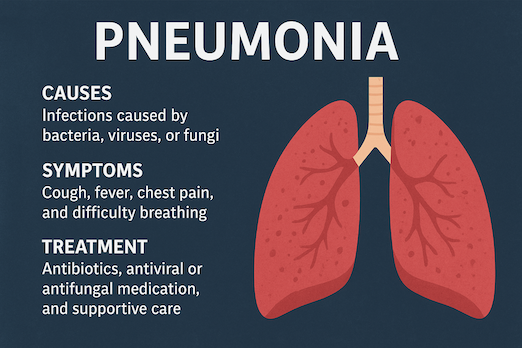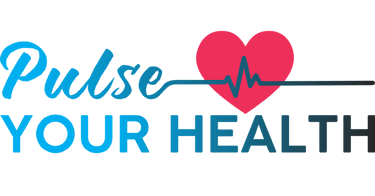Stay updated on what is trending in health. Discover tips and resources for a healthier, balanced life.
Pneumonia: Symptoms, Causes, Treatment, and Prevention
Learn about pneumonia—its causes, whao is at risk, symptoms, treatment & prevention. Understand how to recognize it early and protect your lungs from infection
DISEASES AND CONDITIONS
Dr. S. Ali
10/21/20256 min read


Pneumonia is one of those illnesses many people have heard of—but few truly understand until it hits close to home. It’s more than just a bad cough or chest infection. Pneumonia can range from mild to life-threatening, especially in young children, older adults, and people with weakened immune systems.
Let’s take a closer look at what pneumonia really is, what causes it, how it’s treated, and what you can do to protect yourself and your loved ones.
What Is Pneumonia?
Pneumonia is an infection of the lungs that causes inflammation in the tiny air sacs called alveoli. These air sacs normally fill with air when you breathe—but when you have pneumonia, they fill with fluid or pus, making it harder for oxygen to reach your bloodstream.
This leads to coughing, fever, chest pain, and shortness of breath. The infection can affect one lung (unilateral pneumonia) or both (bilateral pneumonia or double pneumonia).
What Causes Pneumonia?
Pneumonia can be caused by bacteria, viruses, or fungi.
1. Bacterial Pneumonia
This is the most common and often the most serious type. The main culprit is Streptococcus pneumoniae, but other bacteria like Haemophilus influenzae, Staphylococcus aureus, and Klebsiella pneumoniae can also cause it.
Bacterial pneumonia often appears suddenly, with high fever, chills, and a productive cough with yellow or green phlegm.
2. Viral Pneumonia
Viral pneumonia is a lung infection caused by a virus, most commonly influenza (the flu), RSV (respiratory syncytial virus), or SARS-CoV-2 (COVID-19).
Viral pneumonia tends to be milder than bacterial pneumonia, though COVID-19 has shown that severe viral infections can also cause life-threatening pneumonia. Unlike bacterial pneumonia, it does not respond to antibiotics, so treatment primarily focuses on managing symptoms, ensuring proper hydration and rest, and in some cases, using specific antiviral medications.
3. Fungal Pneumonia
Fungal pneumonia is a serious lung infection caused by inhaling spores from certain types of fungi, such as Histoplasma or Coccidioides. Unlike more common bacterial or viral pneumonias, it often originates from the environment—in soil, dust, or bird droppings—and is not typically spread from person to person. It primarily affects individuals with weakened immune systems but can also cause severe illness in healthy people in certain geographic regions.
How Pneumonia Spreads
Pneumonia spreads through the air, usually when an infected person coughs or sneezes. You can also get it by touching contaminated surfaces and then touching your mouth or nose.
Some types, especially bacterial and viral pneumonia, are contagious. Fungal pneumonia, however, does not normally spread from person to person.
Who Is at Risk?
While anyone can get pneumonia, certain groups are more vulnerable:
Infants and young children – Their immune systems are still developing, making it harder to fight off serious infections.
Adults over 65 years – The immune system weakens with age, so a simple cold can more easily turn into pneumonia.
People with chronic illnesses like diabetes, heart disease, or asthma – These conditions put extra stress on the body and lungs, leaving them more vulnerable.
Smokers – Smoking damages the lungs' natural defenses, like the tiny hairs that sweep out germs.
People with weakened immune systems, such as those undergoing chemotherapy or living with HIV – When the body's defense system is compromised, it can't mount a strong fight against the infection.
Hospitalized patients, especially those on ventilators – Being bedridden and having a breathing tube can make it easier for germs to reach the lungs.
Common Symptoms of Pneumonia
Symptoms can vary depending on the cause and severity, but the most common include:
Persistent cough (with or without phlegm) – This isn't your average tickle; it's a deep, lingering cough that just won't quit.
Fever and chills – You might be shivering one minute and sweating the next, as your body fights the infection.
Shortness of breath or difficulty breathing – Even simple tasks like walking across a room can leave you feeling winded.
Chest pain that worsens with deep breaths or coughing – It often feels like a sharp, stabbing sensation when you try to take a deep breath.
Fatigue or weakness – This is more than just tiredness; it's a complete lack of energy that makes you want to stay in bed.
Sweating and clammy skin – You might find yourself drenched in sweat even when you're not doing anything.
Loss of appetite – Food just doesn't seem appealing, even your favorite meals.
In older adults, confusion or drowsiness may be a key sign – If an elderly loved one seems suddenly disoriented or unusually sleepy, it could be a red flag for pneumonia.
Viral pneumonia may start off looking like a cold or flu—with cough, sore throat, and muscle aches—before worsening.
When to See a Doctor
You should seek medical help right away if you experience:
Trouble breathing or rapid breathing – If you feel like you can't catch your breath even while resting, don't wait.
Chest pain that’s persistent or severe – This isn't normal soreness; it's a pressing or sharp pain that signals your lungs and heart are under stress.
High fever or shaking chills – A fever that won't break or chills so strong you're shaking uncontrollably mean the infection is severe.
Bluish lips or fingertips (a sign of low oxygen) – This is a medical emergency; your body isn't getting the oxygen it needs to function.
Confusion or severe fatigue – If you or a loved one can't think clearly or are too weak to get out of bed, it's a major red flag.
Early diagnosis and treatment can make a big difference in recovery.
How Pneumonia Is Diagnosed
Doctors usually start with your medical history and a physical exam, listening to your lungs for crackling or bubbling sounds.
You may also need:
Chest X-ray: To confirm the infection and see how much of the lungs are affected.
Blood tests: To check for infection and identify the type of germ.
Sputum test: To analyze mucus from your lungs for bacteria.
Pulse oximetry: To measure oxygen levels in your blood.
In some cases, a CT scan or bronchoscopy may be done for more detail.
Treatment for Pneumonia
Treatment depends on the cause and severity of your pneumonia.
Bacterial Pneumonia
Treated with antibiotics, usually for 5–10 days. It’s important to finish the full course, even if you start feeling better early.
Viral Pneumonia
There’s no antibiotic for viruses, but antiviral drugs may help in some cases (for example, influenza). Rest, fluids, and fever-reducing medications are the mainstays of care.
Fungal Pneumonia
Requires antifungal medications, prescribed depending on the specific fungus involved.
In severe cases, hospitalization may be needed for oxygen therapy, IV antibiotics, or respiratory support.
Recovery and Outlook
Most healthy adults recover from pneumonia in one to three weeks, though fatigue may last longer.
Older adults or people with other health conditions may take several weeks to regain full strength.
During recovery:
Get plenty of rest and fluids
Take all prescribed medications as directed
Avoid smoking and secondhand smoke
Eat nutritious foods to help your body heal
Even after recovery, some people may have a lingering cough or feel tired for a few more weeks.
Possible Complications
If left untreated or if the infection is severe, pneumonia can lead to complications such as:
Pleural effusion: Fluid buildup around the lungs
Lung abscess: A pocket of pus in the lung
Sepsis: A life-threatening infection spreading through the bloodstream
Respiratory failure: When the lungs can’t supply enough oxygen
These are more common in people with chronic illnesses or weak immune systems.
Preventing Pneumonia
Prevention is always better than cure. Here are some effective ways to protect yourself:
Vaccines are available to prevent many causes of pneumonia:
Pneumococcal vaccine protects against Streptococcus pneumoniae
Flu vaccine helps prevent influenza-related pneumonia
COVID-19 vaccine reduces the risk of severe viral pneumonia
Ask your doctor which vaccines are right for your age and health.
2. Practice Good Hygiene
Wash your hands regularly.
Cover your mouth and nose when coughing or sneezing.
Avoid close contact with people who are sick.
3. Strengthen Your Immune System
Eat a balanced diet rich in fruits and vegetables.
Get enough sleep.
Exercise regularly.
Avoid smoking—it damages your lungs and lowers resistance to infection.
Living With (and After) Pneumonia
After pneumonia, it’s normal to feel weak or short of breath for a while. Take it slow and give your body time to heal. Gradually return to your regular activities.
If you find yourself getting pneumonia often, talk to your doctor. You might need further tests to check for underlying lung conditions, immune issues, or chronic diseases.
Key Takeaway
Pneumonia can sound frightening, but with early diagnosis and the right treatment, most people make a full recovery. Protect yourself by staying up to date on vaccines, practicing good hygiene, and keeping your immune system strong.
If you ever develop a persistent cough, fever, or trouble breathing, don’t ignore it—see your doctor. Catching pneumonia early can make all the difference in your recovery and long-term lung health.
Related Articles:
1. Vaccines: What They Are and Why They Matter to You
Sources
World Health Organization (WHO) – Pneumonia Fact Sheet
https://www.who.int/news-room/fact-sheets/detail/pneumoniaCenters for Disease Control and Prevention (CDC) – Pneumonia Overview
https://www.cdc.gov/pneumonia/index.htmlMayo Clinic – Pneumonia: Symptoms and Causes
https://www.mayoclinic.org/diseases-conditions/pneumonia/symptoms-causes/syc-20354204National Heart, Lung, and Blood Institute (NHLBI) – What Is Pneumonia?
https://www.nhlbi.nih.gov/health/pneumoniaJohns Hopkins Medicine – Pneumonia
https://www.hopkinsmedicine.org/health/conditions-and-diseases/pneumoniaNational Health Service (NHS UK) – Pneumonia Overview
https://www.nhs.uk/conditions/pneumonia/Cleveland Clinic – Pneumonia: Symptoms, Causes & Treatment
https://my.clevelandclinic.org/health/diseases/4471-pneumoniaAmerican Lung Association – Learn About Pneumonia
https://www.lung.org/lung-health-diseases/lung-disease-lookup/pneumoniaMedlinePlus (U.S. National Library of Medicine) – Pneumonia
https://medlineplus.gov/pneumonia.htmlPubMed / National Institutes of Health (NIH) – Recent Research on Pneumonia
https://pubmed.ncbi.nlm.nih.gov/?term=pneumonia
Pulse Your Health
Empowering you to achieve your health goals.
Contact
© 2025. All rights reserved.
Disclaimer: The content on this website is for informational purposes only and is not medical advice. Always seek the advice of your physician or other suitably qualified healthcare professional for diagnosis, treatment and your health related needs.
